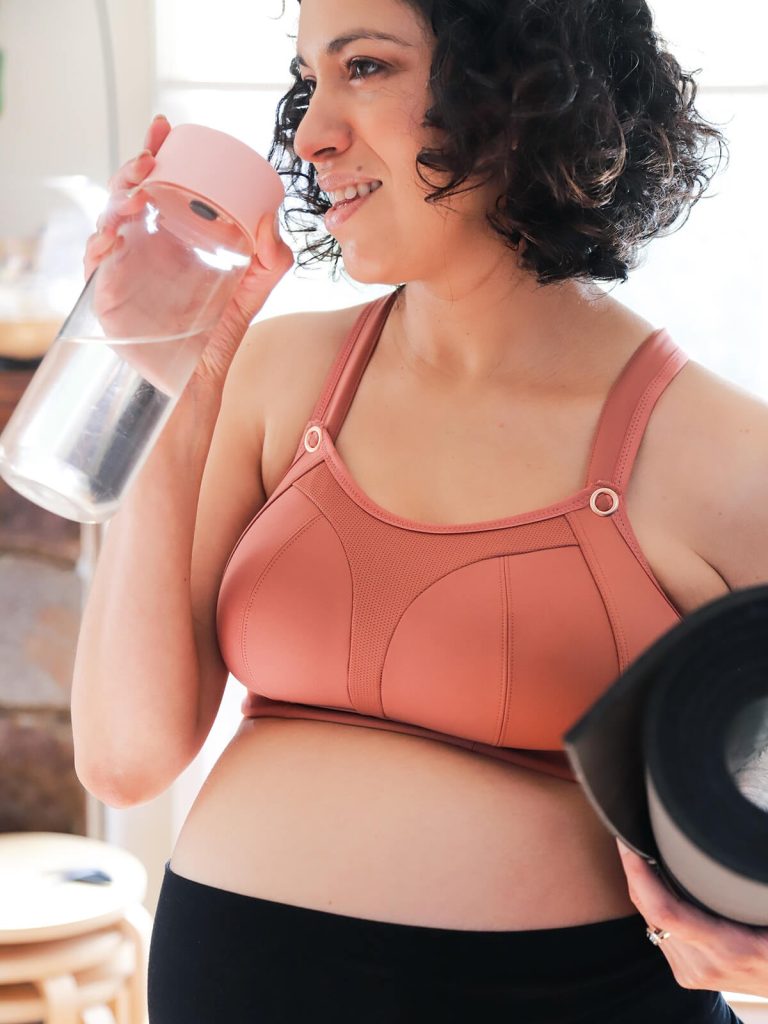Postnatal return to exercise – are you ready?
Whether you’re a seasoned pro or starting out for the first time, it can be hard to know where to start with getting back to exercise following the birth of your baby.
Exercise can have some great benefits after having a baby; it can help you feel better and relieve stress, reduce your risk of postnatal depression as well as helping you recover if you are struggling. Exercise helps to strengthen and tone your muscles (including your tummy muscles) after pregnancy.
Although you might be itching to get going, it’s so important not to rush things. Although the internet seems full of influencers “snapping back” or starting their postpartum exercise regime within hours of giving birth, your body needs time to heal and recover from pregnancy and birth. You’ll thank yourself later.
Why is it important to wait?
Time to heal
Even if you have no wounds on the outside, the area where the placenta has separated from the womb is a wound. This wound usually bleeds for the first 6-8 weeks following the birth of your baby. Like any wound or injury, it needs time, and the right conditions, to allow it to heal. Our bodies are brilliant at healing, when we give them the chance to. You might notice that bleeding gets a little heavier after you start doing a bit more – increased blood flow to the area can cause an increase in bleeding.
If you’ve had stitches from an episiotomy or tear, these will also take time to heal. Doing too much too soon can cause swelling and pain in this area, and can put unnecessary pressure on a healing wound.
If you’ve had a caesarean section, recovery can take longer. It’s a major operation on your tummy, with the doctor needing to cut through several layers of tissues to reach your baby. These all take time to heal and return to full strength. It’s recommended to wait 12 weeks after a caesarean to start exercising. This of course is different for everyone, and when one woman might feel ready is not the same as when another might.
The timeline for recovery from birth varies for everyone. It can be affected by lots of factors including sleep, nutrition, breastfeeding, weight and emotional wellbeing. Doing too much before the body has had time to recover can trigger something called relative energy deficiency (REDs), where the body doesn’t have enough energy to carry out its normal functions. This can have effects on periods, mental health, bone health and likelihood of becoming unwell with infections.
Pelvic health
Pregnancy and childbirth causes significant stretch and strain on the pelvic floor. Research has shown that recovery time for the tissues in the pelvis is between 4-6 months, much longer than the traditionally accepted 6 weeks. Returning to exercise before the pelvic floor is fully recovered can increase the long term risk of pelvic organ prolapse and problems with incontinence.
Changes to your muscles, joints and ligaments
The effects of pregnancy on your body can change the way you stand and walk, and your joints can become less stable. This takes some time to return to normal after your baby is born. Too much too soon, and you run the risk of becoming injured.
So it’s important not to feel pressured into returning to, or indeed starting, a training routine too soon. You really do need time to rest and recover!
Breastfeeding considerations
- Feed your baby before you start exercising; it’s no fun with full breasts!
- Activity and exercise shouldn’t affect the amount of milk you are producing, but make sure you stay hydrated.
- Wear a supportive bra; some choose to wear a sports bra over a normal nursing bra, but some brands are now making specific nursing sports bras. We have paired up with some of our favourite brands to bring you exclusive discounts on nursing sports bras and the rest of their range of maternity and nursing products
- Cake Maternity – 15% off with code MUMIEH15
- Natal Active – 10% off with code MUMIEHEALTH

When can I start?
In the first few weeks after giving birth, you can do some gentle exercises for your core and pelvic floor. This would include pelvic floor exercises and pelvic tilts (tipping your pelvis forward and backwards while arching and curling your back). Your body needs time to recover and it’s important to start really gently.
Walking
You can start gentle walking when you feel ready. A change of scene can do wonders for you both if baby is crying or unsettled, so pop them in the pram, buggy or sling and head out! Not only will this help you clear your head, but it will help offload excess fluid from pregnancy, and reduce your risk of blood clots forming in the legs. Do what you can and don’t push it – listen to your body.
If this feels ok, gradually build up to walking a bit more. Aim to build towards walking for 30 minutes a day 5 days a week. You don’t need to do this all in one go. Two 15 minute walks in the day is fine. And if you feel like doing more, great! But listen to your body; aches and pains are usually a sign it’s too much too soon. Some women find they bleed a bit more once they start moving around more. If this is not excessively heavy and you feel well, it’s nothing to worry about.
Start to build it up
From about 4 weeks postnatal it’s recommended to start building in some gentle resistance exercises, just with body weight to begin with. Add some gentle movement to your daily routine like squats or lunges. And keep going with the pelvic floor exercises.
From 6 weeks it’s ok to start adding in some light aerobic exercise. This could be using a cross trainer, or static bike. It’s likely to take longer than this if you had a tear or a caesarean – again if anything hurts it’s probably too soon.

You might find meeting up with other mums and babies is a good way to get active and socialise. Lots of areas now offer buggy walks and buggy fitness classes. Some gyms also offer parent and baby fitness classes. It’s a great way to meet other parents! We’ve reviewed Buggyfit, a nationally available mum and baby exercise class in a previous Blog – take a look here.
Swimming
Swimming is a great low impact activity that’s gentle on your joints and can strengthen your muscles. It’s best to wait until your bleeding has stopped and stitches or wound have healed. This is likely to be at about 6 weeks.
We spoke to Ashley Jones from Swim England who told us “Swimming is a great way to get active again after having a baby. Exercising in water provides a safe, low-impact opportunity to be active, with recognised benefits on sleep and emotional wellbeing.”
Yoga and Pilates
These are good, low impact activities that will help you build muscle strength and improve function, especially in the tummy muscles. Lots of areas offer mum and baby classes, so you can take little one along with you. There are lots of postnatal specific videos available on sites like Youtube, we love the Pregnancy and Postpartum TV channel on Youtube for workouts pitched at all levels!
Make sure you start easy and build up, however tempting it may be to steam ahead!
High impact activities
It’s best to wait 3-6 months after giving birth to do any high impact activities that involve running or jumping. This is to make sure the pelvic floor and tummy muscles have had time to recover.
If you have any of the following symptoms, either before starting or once you’ve done high impact activities, it’s recommended to stop. Speak to your GP about a referral to a physiotherapist who specialises in pelvic health.
- Incontinence (leaking of wee or poo)
- Heaviness/dragging feeling in the pelvis
- Discomfort while having sex
- Difficulty fully emptying your bowels
- Significant separation of your abdominal muscles, or diastasis recti
- Pain in the lower back or pelvis, either there before, during or after impact exercise
Provided you don’t have any of the above symptoms and you are recovering well from birth, you should be good to give higher impact activities a try. We always recommend starting gently to begin with. A Couch to 5k programme is a great way to get back into running. If you develop any of the above symptoms when you start running, it’s important to scale it back and speak to your GP or Women’s Health physiotherapist. Remember leakage is common, but it’s not normal.
Once your baby is 6 months old, you can even run with them in the buggy. We’d always recommend using a buggy that’s properly designed for running, with a lockable front wheel. We are huge fans of the Out n About range.
Want to know more about postnatal running? Check out this blog from leading postnatal physiotherapists Grainne Donnelly, Tom Goom and Emma Brockwell, on returning to running for women after having a baby.
Getting active again after having your baby has so many benefits; but it’s important for your long term health to listen to your body and take things at your own pace. Everyone will recover at their own pace. If you need to wait, your body will thank you in the long run.


 by laura
, Last updated March 5th, 2024
by laura
, Last updated March 5th, 2024